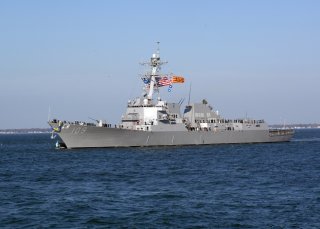Cutting Aegis-Class Warship Funding Sends Wrong Message to China
The U.S. Navy will reportedly request funding for eight new vessels in the next fiscal year budget, down from the twelve that had been sought in a Trump administration blueprint that called for the building of a vastly larger fleet of ships and submarines.
In April, the keel for the future USS Harvey C. Barnum, Jr. (DDG 124) was ceremoniously laid at the General Dynamics Bath Iron Works, located on the Kennebec River in Bath, Maine. The warship will be the seventy-fourth Arleigh Burke-class destroyer built for the U.S. Navy. It was named Col. Harvey ‘Barney’ Barnum, Jr. (USMC, Ret.), a Vietnam War Medal of Honor recipient.
The ship’s namesake, Col. Barnum and his wife and ship sponsor, Martha Hill, attended the event. They were joined by Acting Secretary of the Navy, Thomas W. Harker, Maine Senators Susan Collins and Angus King, Jr., and Member of the House of Representatives from Maine, Chellie Pingree.
“Col. Barnum has spent his life in service to our country and it is an honor to lay the keel of his ship,” said Capt. Seth Miller, DDG 51 class program manager. “This ship and all who serve aboard it will be a reminder of the honor, courage, and commitment that Col. Barnum embodies.”
The warship, which was awarded as part of a multi-year contract, is expected to be commissioned in 2024. However, a planned second Arleigh Burke-class destroyer that was to be built at the Bath Iron Works has been cut from the fiscal year 2022 (FY22) Navy budget.
The U.S. Navy will reportedly request funding for eight new vessels in the next fiscal year budget, down from the twelve that had been sought in a Trump administration blueprint that called for the building of a vastly larger fleet of ships and submarines. The Biden administration’s $715 billion Pentagon budget for FY22, which begins on Oct. 1, will call for funding to build four combat vessels and four support ships. That will include two Virginia-class submarines, one Constellation-class frigate but just one instead of two of the Arleigh Burke Aegis destroyers.
Maine Lawmakers Respond
The three aforementioned lawmakers, as well as Rep. Jared Golden of Maine, said in a joint statement that this scaling back on the program would weaken the U.S. industrial base but also send the wrong message to China.
“Since agreeing to a five-year multiyear procurement contract in 2018, the industry had planned for a procurement rate of at least two ships per year through the next fiscal year,” the Maine Delegation of lawmakers said in a letter to President Joe Biden.
“Stability and predictability are crucial to maintaining a healthy shipbuilding industrial base, which the Navy has identified as a ‘national security imperative that must be steadily supported, and grown, to maintain a skilled workforce,’” the letter added.
The delegation further emphasized that America is not keeping pace with China on shipbuilding, and a reduction in large surface combatant ships would hinder the U.S. military’s ability to compete for years to come. The lawmakers also noted that Congress mandated that the Navy expand its current fleet of fewer than 300 ships to 355 ships, a threshold that China has already surpassed.
King, an independent, sits on the Senate Armed Services Committee, while Republican Collins is a member of the Senate defense appropriations panel.
Peter Suciu is a Michigan-based writer who has contributed to more than four dozen magazines, newspapers, and websites. He regularly writes about military small arms and is the author of several books on military headgear including A Gallery of Military Headdress, which is available on Amazon.com.
Image: Reuters

